CHAPTER 13 LEARNING OBJECTIVES - crypt
advertisement
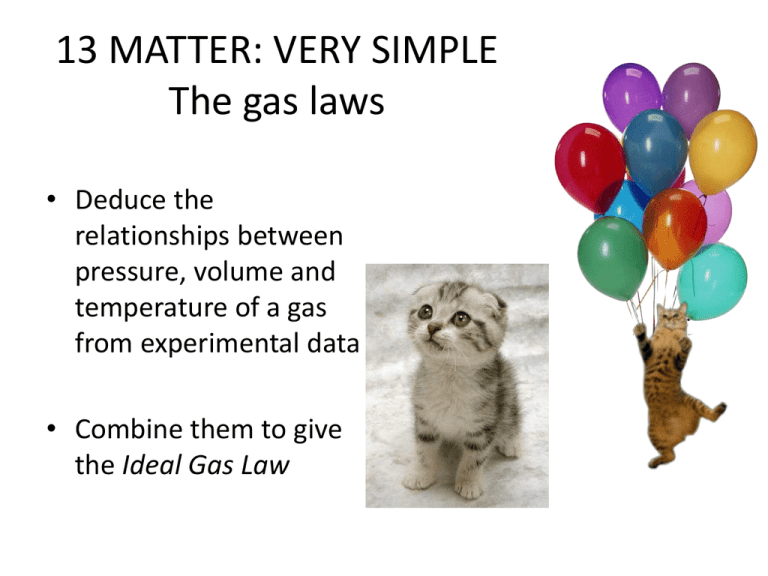
13 MATTER: VERY SIMPLE The gas laws • Deduce the relationships between pressure, volume and temperature of a gas from experimental data • Combine them to give the Ideal Gas Law Boyle’s Law At a constant temperature the pressure p and volume V of a gas are inversely proportional pV=constant 1627-91 What graph could we draw to test this relationship?!? Pressure and volume of gases increasing with temperature Constant volume Constant pressure 1 2 4 3 pressure p 45.1 45.1 volume V T/C T/C heat gas: pressure increases –273 heat gas: volume increases 0 temperature/C –273 0 temperature/C Pressure and volume extrapolate to zero at same temperature –273.16 C So define this temperature as zero of Kelvin scale of temperature, symbol T 0 273 temperature/K pressure proportional to Kelvin temperature 273 temperature/K volume proportional to Kelvin temperature pT VT 0 Pressure and volume proportional to absolute temperature Charles’ Law V/T=constant At constant pressure, the volume V of a gas is directly proportional to its absolute temperature T. Pressure Law p/T=constant At constant volume, the pressure p of a gas is directly proportional to its absolute temperature T. 1780’s Absolute Temperature Absolute temperature measures how hot an object is on a scale starting at absolute zero (lowest possible temperature, when all particles have minimum possible energy). Measured in: Kelvin, K Scale: 1K = 1⁰C Conversion: K = C + 273 E.g.. 0 ⁰C = 273K, 10 ⁰C = 263K, -273K = 0 ⁰C 1800’s Testing Charles’ Law and the pressure Law… 1. Test the laws using the experimental setup suggested on your sheet. 2. Take measurements of volume or pressure at 4/5 different temperatures (doesn’t matter what temps as long as good range) 3. Plot a rough graph of your results. Don’t forget to use absolute temperature… Conversion: K = C + 273 What is a mole? One mole has 6.023 x 1023 particles in it. It has a mass equal to the atomic mass in grams: 1 mole of Carbon = 12g I mole of Hydrogen = 1g One law for all gases Boyle’s law p1/V 1 2 4 3 3 2 pressure p Combine the relationships into one volume V compress gas: pressure p increases constant temperature T Amount law pressure p 2 4 3 Combine unknown N and k into measurable quantity R combine: add more molecules: pressure p increases constant temperature T pV pT 1 2 4 3 5 0 pN/V or pVN number N Pressure law N m–2 combine: pN 1 1 4 105 introduce constant k: pVNkT pressure p Number of molecules N not known Nk can be measured: Nk = pV/T For one mole, define R = NAk For n moles: pV = nRT 45.1 T/K heat gas: pressure p increases constant volume V combine: pVT Charles’ law VT k = Boltzmann constant NA = Avogadro number (number of molecules per mole) R = molar gas constant = 8.31 J K –1 mol–1 measured from pV/T for one mole 45.1 volume V T/K heat gas: volume V increases constant pressure p When NA could be measured: Avogadro number NA = 6.02 1023 particles mol–1 R = molar gas constant = NAk = 8.31 J K–1 mol–1 Boltzmann constant k = 1.38 10–23 J K –1 mol–1 One beautiful equation…. pV = nRT n is the number of moles R = molar gas constant (JK-1mol-1) Energy the gas has per Kelvin per mole Boltzmann constant is derived thus: k = R/NA JK-1per particle Energy the gas has per Kelvin per particle pV = nNAkT = nRT Summary…. pV = constant (if T is constant) V/T = constant (if p is constant) p/T = constant (if V is constant) Combine to give the Ideal Gas law… pV = nRT or pV = NkT Where… n = number of moles (amount of gas) R = Molar gas constant (8.31J mol-1K-1) k = Boltzmann constant (1.38x10-23JK-1) N = number of particles Ideal Gases Develop problem solving skills involving the gas laws. Derive the relationship density = PM/RT A sealed aluminium alloy flask contains air at atmospheric pressure and a temperature of 27 oC. The alloy’s melting point is 620 oC, and the flask will burst if the pressure exceeds 2.9 atmospheres. Will the flask melt before it bursts, or burst before it melts? Determining the density of air A plastic vessel (40 cm x 40 cm x 40 cm) containing air at atmospheric pressure is weighed. Its mass is recorded as 371.2 g. The air in the vessel is pumped out and the vessel re-sealed. Its mass is now 300.3 g. From these results, work out the density of air in kg m-3. ρ = mass/volume kgm-3 ρ = density Upthrust… Where does the force come from that causes a hot air balloon to rise? Archimedes: Any object in a fluid displaces a volume of the fluid that weighs more than the object does, will float upwards. Bye Bye Kitty……….. A sadistic physicist decides to find out how many helium party balloons need to be attached to a kitten to make it take off. He knows that the upthrust force on a helium balloon is given by the weight of air displaced by it. Mass of kitten = 0.25 kg Volume of a party balloon = 0.027 m3 Mass of balloon (excluding gas in it) = 0.005 kg Air density = 1.1 kg m-3 Helium density = 0.15 kg m-3 Work out how many balloons are needed to make kitty fly! ρ = m/V kgm-3 ρ = density Hint………………….. For one balloon, work out the net upward force by calculating the Hint: For one balloon, work out the net force by calculating the up thrust force upthrustupward force and the weight of and the weight of balloon plus contents. Hint: For one balloon, work out the net upward balloon plus contents. force by calculating the up thrust force and the weight of balloon plus contents. Derive… ρ = pM/RT ρ = density p = pressure M = molar mass R = universal gas constant T = Absolute Temperature n = number of moles m = mass Using the following…. pV=nRT, ρ=m/V, n=m/M Gas density Instead, you are going to derive an equation for gas density in terms of the intensive properties of pressure, molar mass and temperature, all of which are easy to determine. 1. Write down the ideal gas equation (molar form) 2. Write an expression for n, the number of moles in terms of the mass of gas, m, and the molar mass M. 3. What is the standard expression for the density of a substance? 4. Substitute equation 2 into equation 1 and rearrange to give the correct expression for density on one side. 5. Use your new equation to calculate the density of air at atmospheric pressure (105 Pa) and 25 oC. Take the molar mass of air as 28.6 g mol-1. Kinetic theory of gases • Derive PV = nRT from a kinetic theory standpoint • Derive expressions for kinetic energy and molecular speed from the resulting equations Kinetic theory of gases Law Boyle’s Law Pressure Law Charles’ Law “Amount” Law Relationship in Kinetic theory explanation terms of variables P α 1/V Kinetic Theory A model that attempts to explain the gas laws. First some assumptions (of an ideal gas) • Gas contains large number of particles • Molecules move randomly at random speeds. • All collisions between wall and particles are elastic. • Low density so space occupied by molecules is zero • Energy of motion large enough so that attractive forces can be ignored. Momentum Recap… p = mv F= Δp/Δt Impact of a ball on a wall (Qs 50S) (3mins) A ball of mass 2 kg, moving at 12 ms–1, hits a massive wall head-on and stops. 1. How much momentum did the ball have before impact? 24 kgms-1 2. How much momentum does the ball have when it has stopped, after impact? 0 kgms-1 3. How much momentum did the ball lose during impact? 24 kgms-1 4. Assume that Newton’s third law is correct and applies to this case. How much momentum did the wall gain? 24 kgms-1 Force due to a stream of elastic balls Suppose the wall is hit by a stream of 2 kg balls. In this case each ball arrives with a speed of 12 m s–1 and bounces straight back with an equal speed of 12 m s–1 in the opposite direction. As previously, 1000 balls arrive at the wall in 10 s. 8. Calculate the change of momentum when 48 kg m s–1 one ball arrives at the wall and bounces away. 9. Calculate the change in momentum for all the 1000 balls. 48000 kg m s–1 10. Calculate the average force on the wall during that 10 s period. 4.8 kN Deriving the ideal gas equation from kinetic theory Consider a cuboid, dimensions x,y,z, containing a single gas molecule of mass m travelling at speed v along the X direction. The molecule collides elastically with wall YZ and then travels in the opposite direction towards the other YZ wall. Q1. Show that the time between collisions of the molecule with the same wall is t = 2x/v. Q2. What is the rate at which the molecule collides with the wall? Q3. The molecule collides elastically with the wall and rebounds in the opposite direction. What is its change in momentum? Q4. Newton’s second law can be stated as Force = rate of change of momentum. Use this together with your answers to the previous questions to show that the average force on YZ due to the molecule colliding with it is F = mv2/x . Q5. Use the basic definition of pressure (pressure = force/area) and your answer to the last question to derive an expression for the pressure P exerted on wall YZ by the single gas molecule. Kinetic model of a gas To start: one molecule in a box Use change of momentum end wall of box momentum +mv before impulse on wall v y momentum –mv after z x round trip-time between collisions t = 2x /v collisions per second = v /2x wall has change in momentum +2mv ball has change in momentum –2mv momentum 2mv given to wall at each collision Force = rate of change of momentum force on wall = momentum per collision collisions per second 2mv v/ 2x t force time force on wall = mv 2 / x impulse each time molecule returns Calculate pressure = force on wall/ area of wall pressure p y force on wall = mv2/x 2 t force on wall = momentum per collision collisions per second 2mv v/ 2x force time force on wall = mv 2 / x impulse each time molecule returns Calculate pressure = force on wall/ area of wall force on wall = mv2/x pressure p y pressure = mv2/xyz (area = yz) xyz = volume V z x pressure p = mv 2 /V area of wall = yz add many molecules all doing the same (V = xyz) improve model force N times as many collisions per second pressure p = Nmv2/V N molecules allow molecules to move in random directions time improve model force time 1/3 as many collisions per second Deriving the ideal gas equation from kinetic theory Now we need to extend the model to a more realistic situation where many gas molecules are colliding with the walls. Q1. If there are N molecules in the gas, how many, on average, will be travelling in the x direction? Q2. Using your expression for the pressure due to one molecule and your answer to the previous question, show that the pressure due to all molecules is given by P = Nmv2/3V . Q3. We normally write the equation from the previous question as PV = 1/3 Nmv2, where we now allow the molecules to travel at a range of speeds characterised by a mean square average speed. Can you see any similarities with the experimental ideal gas law? Q4. Write down an expression for the kinetic energy of a gas of N molecules of mass m. Q5. Combine the expression from the previous 2 questions to show that the kinetic energy of the gas is given by KE = 3/2 PV. Q6. The KE of a substance is proportional to its temperature T. Use this to show that PV α T as in the experimental ideal gas law. Q7. Show that, for molar quantities, KE = 3/2 RT = 1/2 Mv2, where M is molar mass. Q8. Use the equation from the previous question to estimate the speed of nitrogen molecules in the room around you. N times as many collisions per second pressure p = Nmv2/V N molecules allow molecules to move in random directions time improve model force time 1/3 of molecules in each direction, on average allow molecules to move at random speeds 1/3 as many collisions per second pressure p = 1 3 Nmv2/V improve model force time average impulse stays the same take average over v2 The kinetic theory of gases predicts that pV = 13 Nmv 2 1 pressure p = 3 Nmv2/V p = 1/3 From the 3 dimensions of the box 2 Nmv / V Average of square of speeds of molecules v1 Mass of one molecule v3 v7 v2 v4 v6 v5 Compare…. pV = 2 1/3Nm𝑣 & pV = NkT Average KE of a molecule = 3/2kT Total KE of N molecules = 3/2NkT Kinetic energy of one mole of molecules U = 3/2RT r.m.s speed, 𝟐 𝒗 (Root Mean Square Speed) mean speed most probable speed root mean square speed 0.10 0.08 0.06 0.04 0.02 0.00 speed in metre per second A way of averaging speeds. The distribution of speeds of molecules in nitrogen at 300 K is shown here. r.m.s speed, 𝟐 𝒗 Remember… Average KE of a molecule = 3/2kT So… 1/2m𝑣 2 = 3/2kT Average of square of speeds of molecules Therefore…. 𝑣 2 = 3𝑘𝑇 𝑚 And …. vr.m.s = 3𝑘𝑇 = 𝑚 3𝑅𝑇 𝑀 Kinetic Theory (Part 2) Develop problem solving skills associated with kinetic theory of gases, including the calculation of r.m.s speeds. Starter: Estimate the speed of air molecules in this room Speed of a nitrogen molecule Assume warm room temperature T = 300 K mass of 1 mole of N2 = 28 10–3 kg mol–1 kinetic energy of a molecule Avogadro constant NA = 6 1023 particles mol–1 from dynamics Boltzmann constant k = 1.38 10–23 J K–1 mass m of N2 molecule 1 2 from kinetic model 3 kT v2 = m mv2 calculate speed mass of 1 mole of N2 m= Avogadro constant NA 3 1.4 10–23 J K–1 300 K v = 4.7 10–26 kg 28 10–3 kg mol–1 m= 6 1023 mol–1 v2 = 2.7 105 J kg–1 [same as (m s–1)2] m = 4.7 10–26 kg 2 v = 500 m s–1 approximately Air molecules (mostly nitrogen) at room temperature go as fast as bullets 3 2 kT Diffusion of gases and liquids • Observe and explain diffusion effects in liquids and gases • Derive and apply the Einstein equation for diffusion Evidence for m oving molecule s Brom ine expand ing in to a vacuum remove air from tube using vacuum pump attach bromine capsule in sealed tube: break capsule open tap: bromine instantly fills whole tube bromine to vacuum pump tap closed air in tube tap open vacuum bromine in tube Brom in e diffu sing in to air bromine very gradually diffuses up the tube attach bromine capsule in sealed tube: break capsule bromine tap closed air in tube tap open bromine diffuses into tube Diffusion shows that molecules move. Rapid diffusion into a vacuum demonstrates high molecular speeds Random walk in 1 dimension Suppose a molecule can either move one step to the right (R) or one step to the left (L) as a result of collisions with neighbouring molecules. There is a 50 % chance of stepping to the right as a result of a collision, and a 50 % chance of moving to the left. Assume the distance moved in a step is always the same. Consider a molecule that starts in a certain place and then experiences 10 collisions. Q1. How many different outcomes are there for a sequence of 10 steps? (Hint: one such outcome is LRLLLRRLRL) Q2. What is the maximum distance from the start, measured in number of steps, that a molecule could end up after 10 collisions? How likely is this outcome? Q3. Consider a molecule that ends up at 8R after 10 steps. How many different ways are there of reaching this position in 10 steps? Enumerate them. Q4. What about a molecule that ends up at 6R after 10 steps? How many different ways are there of reaching this position in 10 steps? Q5. Which is the most likely place for a molecule to end up after 10 steps? Explain your answer. Q5. Can you sketch a graph to show the distribution of molecules about the starting position after 10 steps? Explain the shape of the graph you have drawn. Random walk distribution after 10 steps 300 250 200 n 150 100 50 0 10L 8L 6L 4L 2L 0L 2R 4R 6R 8R 10R Gaussian or Normal distribution with standard deviation = √N = √10 = 3.2 In general, if N steps are taken, estimated distance diffused D = √N x d, where d is the “step length” or mean free path . Diffusion of perfume across a room How far do molecules of perfume diffuse in 2 seconds? Take the rms speed of the molecules as 500 ms-1, and the mean free path (step length or average distance between collisions) as 10-7 m. Hint: Work out the distance gone in 2 seconds, and then work out how many collisions are experienced in travelling this distance. A sixth form student is still recovering from a big night out and randomly walks around not knowing where he is going. Sixth form centre Estimate how many steps will it take for a student to randomly walk from common room to this lab Lab Diffusion of photons through the radiative zone of the Sun Photons that are created during fusion in the core of the Sun can take a very long time to reach the surface and be emitted. This is because they undergo a vast number of collisions as they are scattered by protons, electrons and other particles in the radiative zone. In this exercise, your task is to estimate how long it takes a photon to traverse the radiative zone as it undergoes many randomising collisions. Diffusion in the Sun Data: Depth of radiative zone: 109 m Mean free path of photon: 0.01 m (distance between successive collisions) Speed of photon: 3 x 108 ms-1 1 year = 3 x 107 seconds Q1. Using the random walk model, how long does it take a photon to travel through the radiative zone? Q2. Will more photons take a greater or less time to transit the radiative zone than the value calculated in Q1? Q3. What factors will affect the mean free path of a photon, and how will they affect it? Q4. Predict and explain the effect of increasing the mean free path on the time taken to transit the radiative zone. Internal energy and specific thermal capacity • Explain and use the equation E = mc • Explain the consequences of the anomalous STC of water • Explain the pattern in molar STC values for metals • Apply the First Law to thermodynamic problems Starter: What is the kinetic energy of 1 mole of an ideal gas at 300 K? Use R = 8.3 J K-1 mol-1. How much energy would you need to supply to raise the temperature of 1 mole of an ideal gas by 1 degree K? Compare…. pV = 2 1/3Nm𝑣 & pV = NkT Average KE of a molecule = 3/2kT Total KE of N molecules = 3/2NkT Kinetic energy of one mole of molecules U = 3/2RT Molar Specific Thermal Capacity U = 3/2 RT (internal energy) Molar STC = dU/dT = 3/2 R “The molar specific thermal capacity (C) of a substance is the amount of energy needed to raise the temperature of 1 mol of substance by 1K (1⁰C)” Unit: J mol-1 K-1 Specific Thermal Capacity “The specific thermal capacity (c) of a substance is the amount of energy needed to raise the temperature of 1kg of substance by 1K (1⁰C)” Unit: Jkg-1K-1 How much energy to have a bath? What do we need to know? - Mass of water - STC of water - Temp change ΔE=mcΔθ (at constant volume only) STC of metals Metal Aluminium Copper Lead Iron Mercury Magnesium Silver Platinum Gold Molar mass (kg mol-1) Specific thermal Specific thermal capacity capacity (J kg-1 K-1) (J mol-1 K-1) 900 390 130 450 140 1020 230 130 130 Complete the table and comment on the result. Do you see any connection with the molar STC values for monatomic gases? E = mc Q1. The STC of water is 4200 J kg-1 K-1, much higher than the STC values of most other materials (see p111). Convert this STC into molar units and compare it with the molar STC of ethanol, 112 J K-1 mol-1. Q2. The anomalous STC of water can explain many phenomena. Do the following exercise to predict and explain which way the wind blows at the sea side on a sunny day. (a) Solar radiation of intensity 1000 W m-2 is incident on a 1 m3 “block” of sea water for 1 hour. Calculate the temperature rise in the sea water, assuming all the energy is absorbed. Density of water = 1000 kg m-3. (b) Consider a 1 m3 block of land rock. Calculate the corresponding temperature rise in this block of rock, assuming the same intensity and heating time. Density of rock = 2700 kg m-3, STC of rock = 880 J kg-1 K-1. E = mc (c) If the air above the land and the sea is heated efficiently by thermal contact with those bodies, can you explain the origin of breezes coming off the sea during the day? (d) Sail powered fishing boats used to leave harbour at night. Explain why. (e) Can you explain why, even in the absence of the Gulf Stream, the British Isles would have a more temperate climate than other countries on the same latitude such as Canada and Russia? STARTER Q1. Here are the specific thermal capacities for some gases at 300 K, in units of J g-1 K-1. Use their molar masses to convert them into units of J mol-1 K-1. Ar 0.31 02 0.66 I2 0.145 N2 0.74 CO 0.74 Q2. Can you see any patterns in the results? Q3. Can you explain the trends/patterns you see? Hint: What is the STC for an ideal gas (with translational KE only)? The First Law of Thermodynamics • State and explain the First Law of Thermodynamics • Use the First Law to solve problems where gases do work First law of Thermodynamics Energy cannot be created destroyed. However it can be transferred from one place to another. ΔU = W + Q ΔU – Change in internal energy of a material W – work done on material Q – Energy transferred thermally The First Law of Thermodynamics In what follows, we will consider ideal gases, but the First Law applies to all substances. Q1. Energy can be supplied to a gas in two ways. Describe them. Q2. Write down the equation that summarises the First Law, identifying the terms clearly. What property of the gas gives an indication of its internal energy? Q3. If a gas expands and does work against its surroundings, and no heat energy is lost or supplied, does the gas lose or gain internal energy? Q4. If heat energy is lost from a gas and it does no work, what can you say about its final internal energy? Q5. For the following changes, predict and explain whether the final temperature of the gas will be higher or lower than at the start: (a) 2000 J of work are done on the gas and 3000 J of thermal energy are supplied. (b) The gas does 2000 J of work and 1500 J of thermal energy are supplied to it. (c) 4000 J of work are done on the gas and 3000 J of thermal energy are supplied to it. Q6. (a) What is the internal energy of 100 moles of argon gas at 25 oC? (R=8.3 JK-1mol-1) (b) What volume would the gas occupy at 100 000 Pa pressure? (c) The gas is allowed to push back a piston of area 0.25 m2 over a distance of 15 cm. Calculate the work done by the gas. (Hint: Work = force x distance. Ignore any pressure change.) (d) If 4000 J of heat energy are lost by the gas during the expansion, calculate its final internal energy and hence its final temperature. The first law An ideal gas at 27 oC is contained in a cubic container of side length 50 cm. The gas pressure is 1x 105 Pa. Q1. Calculate the number of molecules of gas in the container. (k=1.4 x 10-23 J K-1) Q2. Estimate the internal energy of the gas in the container. Q3. The container is compressed on all sides until each side has shortened in length by 10 %. Calculate the new pressure, assuming that the compression happens isothermally (no change in temperature). Q4. Compressing the gas involves doing work. Where does this energy go if the compression of the gas is being carried out isothermally? Q5. Estimate the work done on the gas when it is compressed. Hint: Work = force x distance = pressure x volume change Q6. If the container is instead thermally isolated when the compression takes place, estimate the final temperature of the gas. Otto Engine... Determining the temperature of a Bunsen flame • Devise and carry out an experiment to determine the temperature of a roaring Bunsen flame • Consider critically random measurement uncertainties and systematic errors Starter: A blacksmith heats a 1.1 kg iron horseshoe in a forge. When the shoe is very hot, he plunges it into a tub of 15 kg of cold water at 10 oC. The temperature of the water is observed to rise by 10 oC. To what temperature had the horseshoe been heated? STC of water= 4200 J kg-1 K-1 ΔE = m c Δ Θ STC of iron = 450 J kg-1 K-1 What assumptions do you need to make? ΔE = m c Δ Θ A blacksmith heats a 1.1 kg iron horseshoe in a forge. When the shoe is very hot, he plunges it into a tub of 15 kg of cold water at 10 oC. The temperature of the water is observed to rise by 10 oC. To what temperature had the horseshoe been heated? STC of water= 4200 J kg-1 K-1 STC of iron = 450 J kg-1 K-1 Uncertainty and Error Random uncertainties • Identify sources of measurement uncertainty and quantify them. • Which contributes the most to the uncertainty in the final answer? Systematic errors • Identify limitations in the design of the experiment and explain how they could either be eliminated or reduced in effect.

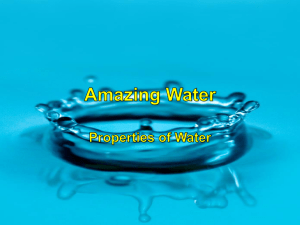
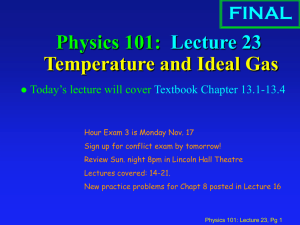
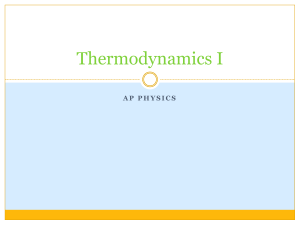
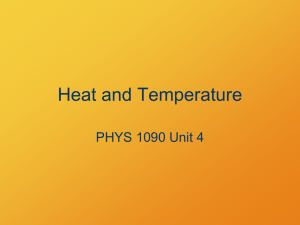

![[PowerPoint 2007] presentation file](http://s2.studylib.net/store/data/005406460_1-7834316c409f9802f7aec3d8538324fb-300x300.png)
